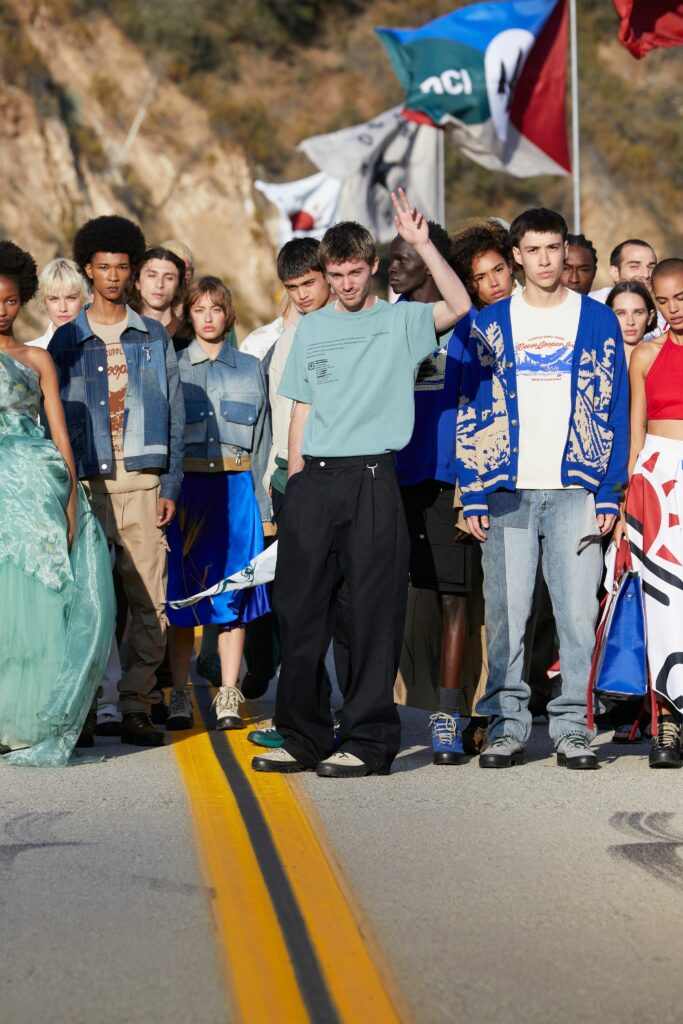Reese Cooper’s breath of fresh air

Along the East Fork Bridge, nestled high in California’s San Gabriel Mountains, Reese Cooper’s friends and family assembled to witness a procession of models parade in his latest collection. The 23-year-old designer was thinking, once again, about the great outdoors. Unlike previous seasons where design development comes before location scouting, Spring Summer 22 compounded the tasks giving way to a conversation between place and clothing.
Entitled Fresh Air, the show is a continuation of his appreciation of the natural world, replete with various renditions on outerwear from men’s bomber and work jackets, hoodies, and supple work pants (decorated with pockets for practical use) in earthen tones, and juxtaposed with cobalt blue and red. He loosened the narrower silhouettes from last season to something roomier, owing, he said, to the post-lockdown desire to look and feel comfortable. Yet Cooper skirted around a slapdash or sloppy outcome by imbuing his outerwear with a sophisticated flair achieved primarily through tailored styles.
Notable additions to his vernacular are a collaboration with American denim brand Levi’s and a fortified womenswear lineup. Working closely with Levi’s sustainability team, Cooper repurposed deadstock inventory to reconstruct patchwork jackets and jeans. For him, the collaboration was a no-brainer: “Every season, my denim is made with deadstock American denim from mills in Los Angeles and it’s washed and dyed with zero carbon footprint practices. Sustainability in denim is very important to me – and the only way to top that was to not use our own denim at all – so the Levi’s collaboration was fun to work on.”
As for womenswear, Cooper expanded on his typically unisex fare with an elevated offering for his female clients, which included a smattering of silk blouses and scarves printed with floral imagery, layered organza jackets, and dresses made from three layers of crystal organza with 80-metres of gathered tulle underneath.
We spoke to the self-possessed designer over Zoom to discuss his new collection, collaboration, and his developing brand identity.
Can you share the starting point for the collection?
This came much later than normal. I usually try to work with as much time between each show but we didn’t start until April due to manufacturing issues. We had to find different vendors to work with but somehow came out the other side of that. The timing meant that the location scouting and collection design process began at the same time, so for the first time in a while since doing lookbooks, those got to go hand in hand. Finding the East Fork Bridge in the San Gabriel Mountains [with a] story built around a trail runner [where] the colour palette of that place became the colour palette of the collection.
Could you speak to the presentation format?
We’re doing a film with a trail runner called Gordon. He was wearing a huge rig with a 30lb counterweight on his back and running through the valley. It starts off following his perspective for a couple of minutes as he runs around the mountain trail before he stumbles upon the show, and he looks around confused. He’s thrown into hair and makeup, he’s in the trailer with KAYTRANADA [the Grammy-winning artists who soundtracked the show], and ends up walking the show.
Was expanding womenswear something your customers asked for, or was it a personal project?
I think it’s 50/50. I take any and all feedback, so whenever girls that I’m friends with suggest something, I consider that and see how it might feed into design. I got sick of the womenswear being very reflective of the menswear. If there’s a time to change the direction that this is going it’s now: let’s have some fun with it. My womenswear market is not as big as the men’s so it was lower stakes to try new and exciting things, but this felt like the right time to give it a shot.
Did you adapt your brand identity during the pandemic?
I think the pandemic has reinforced our beliefs and inspirations because we got to spend the last three seasons in our own back garden. Every season [of mine] is inspired by where we live and work and for the first time, we’ve been able to show the work in that space. Everything is able to be designed a bit more to purpose and more thought-through because you can add personal touches. For example, the camo patterns in the collection are made from the foliage on trails that we hike on. And [fine artist] Juliet Johnstone painted florals that were printed on womenswear and leather accessories.
Do you think this period has given you more time to experiment?
It’s that comfort zone thing of being able to work in your hometown for so long. We’ve been working here at the studio which is close to my house, with a small group of friends that come by every now and then. You feel comfortable to try new things. It gives you more freedom to operate.



